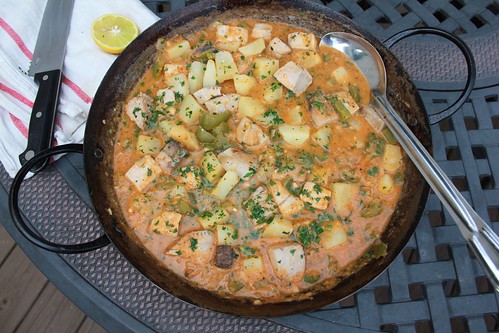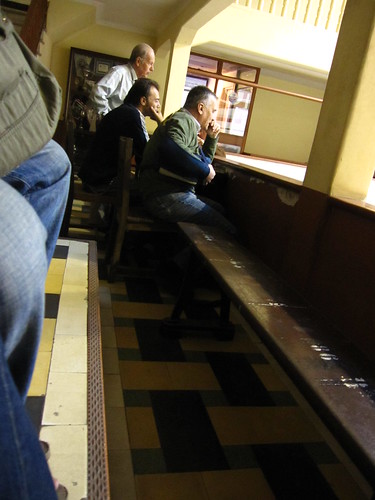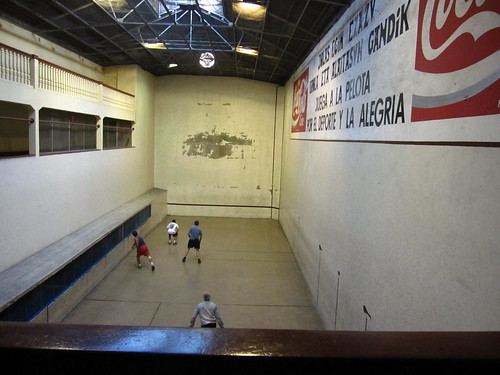
When the coughing and farting of the antique truck had rumbled away, between the rustlings of birds pecking grubs among the dry plane leaves, you could just make out the pop and thwack of rubber on concrete. Ascending a double flight of unusually steep stairs, past a stained glass window featuring farming folk, the squeak of gym shoes and the grunts of the players become audible. At the top, a cry of “Buen remate, cabrón!/Good shot, motherf—er!” greeted us as we emerged into a small, tiered seating area perched some twenty feet above an enclosed court. On wooden benches, polished to a veneer by generations of spectator buttocks, a handful of thickset older men, sipping beakers of black wine, like Statler and Waldorf from The Muppets, were joyfully goading the four sweaty men haring after a small rubber ball below them.

The oak-paneled bar area to our left was bedecked with green and red flags and football scarves, and populated only by an unshaven barman polishing glasses absently with his shirt-tail. Feeling rather conspicuous, we perched on the edge of a bench and peeked over the parapet and immediately recognized the game. Anyone who has spent any time in New York City has seen kids and adults alike playing “handball” in courts in municipal parks. Usually played 1-vs-1, a flat rubber ball is hit with the palm of the hand against a wall with roughly the same purpose and rules as squash. Here the players were paired in teams and like in New York were wearing gloves or had applied tape to their palms as padding. However, unlike our corner park in Brooklyn, this court was at least fifty yards long surrounded on four sides by high walls giving it the peculiar gladiatorial aspect of a pit.

Properly-named, the court is the frontón and pelota – ball – as it’s simply referred to, is the game. Playing and watching were members of Montevideo, Uruguay’s, lively Basque community, in this, their community center, Euskal Erria, the Basque institution. After a short while, the players tired and finished their game, and the spectators strolled off back down the stairs. Pelota is the signature sport of the Basques and its familiarity to North Americans has a lot to do with Basque emigration to the New World and Basque clubs like this one scattered around North and South America.
Basques from both the French and Spanish sides of the Pyrenees have been arriving in the New World ever since it was discovered, but their emigration accelerated towards the end of the 19th century as shortages of land and a series of poor harvests drove many French Basques to seek their fortunes in South America. Usually on the wrong side of history, most Spanish Basques chose the Republican cause in the Spanish Civil War and once again found themselves singled out for special persecution as Franco’s fascists got the upper hand. Fearing for their lives, but anticipating that their exile would be temporary, hundreds of thousands of Basques landed in the Americas during the 1930s. The vast majority went to the Southern Cone of South America – to Argentina, Chile and Uruguay – though many chose Venezuela and Puerto Rico, as well as the western US where even today they form the majority of America’s shepherds.

Retiring to the oaky comforts of the bar that lunchtime in Montevideo, and disturbing the otherwise somnolent barman, we sat by a sunny window overlooking the turning leaves of the plane trees below us and refreshed ourselves with a large jug of pink wine. Picking through a plate of fiambres y quesos Uruguayos with some excellent salami and some curiously yellow cubes of cheese we remarked on the European-style plates embossed with the club’s name and crest, an oak tree. Next came a very disappointing and similarly yellow paella decorated with some giant head-on shrimp and a few over-sized chunks of raw carrot. It was our only departure from meat in Uruguay but was enough to encourage us to remain carnivorous for the remainder of our stay. Basque immigrants to Uruguay, you see, typically either worked the land or in business, unlike their compatriots in the homeland where fishing remains an important part of the economy. Consequently, it appears that aspect of Basque culture that has been lost among their Uruguayan descendants.

The legacy of persecution has made the Basque passionate about retaining his culture, traditions and language, and clubs like this one in Montevideo sprang up wherever Basques settled. Euskal Erria, founded in 1912, was the second such club to be founded in the Uruguayan capital when members of the first, Centro Euskaro, disagreed over who to favor in the Carlist Wars. That the two have never reconciled speaks to what many would perceive as the stubbornness typical of the Basque temperament. Indeed, the common perception of Basques in Europe formed by reports of the terrorism of para-military separatist group ETA, is quite different from the prevailing view in South America where Basques are typically considered more honest, tougher, harder-working, and richer than the average. Former President of Chile Patricio Aylwin whose Welsh surname belies his Basque ancestry, once claimed that “the two greatest accomplishments of the Basques are the Republic of Chile and the Jesuits.”
A few years earlier, during a journey through the French and Spanish Basque lands, we visited the Sanctuary of Saint Ignatius Loyola, founder of the Jesuits, in Azpeitia, Gipuzkoa, and witnessed first-hand the reverence for the Basque Country’s most renowned son in all its Churrigueresque splendor. Later that day, having made it to the coast, we enjoyed the kind of seafood lunch for which Basque cuisine is rightly famous. For €9, at a tiny oak-clad cantina in the village of Zumaia, a carafe of the slightly carbonated local white wine known as txakolà washed down a feast of grilled sardines and the classic Basque tuna (bonito) and potato soup/stew, marmitako.

It was coming up on 10 years since that lunch and so it seemed timely to revisit it. Nothing could be simpler or more straightforward. Using the paella pan that we bought at a street market in Montevideo – hand-hammered by a certain M. Giannichini – it was the perfect vessel for marmitako. Wide enough to saute, tall enough at the sides to accommodate the liquid. It is also a perfect articulation of the half-Spanish and half-Italian Uruguayan identity of which we were just about to learn that Basque is an important third leg.

Marmitako – Basque tuna and potato soup/stew
(Serves 4)
Ingredients
- 1.5lbs tuna steaks, Ahi or Skipjack is perfectly adequate
- 1 large onion, chopped
- 4 medium tomatoes, skinned and cubed
- 1 green pepper, choped
- 4 cloves garlic, chopped finely
- 2 tablespoons chopped Italian/flat-leaf parsley
- 2.5lbs potatoes, peeled and cut into 1inch cubes
- 1 teaspoon ground ñora pepper (Aleppo pepper is a great substitute)
- 1/4 cup Spanish brandy
- 3-4 tablespoons olive oil
- Boiling water or fish stock
- salt and black pepper
Recipe
- In a wide pan with tall sides, heat 1 tablespoon of olive oil over medium heat and gently saute half the onion until translucent.
- Add the chopped tomatoes and parsley and cook until softened.
- Add brandy and allow alcohol to evaporate before emptying pan contents into a blender and blitzing until smooth.
- Reserve blended ingredients and rinse pan before returning to heat.
- Add remaining olive oil and gently saute remaining onion and green pepper with garlic until fragrant and translucent.
- Add cubed potatoes and enough hot fish stock or hot water to just cover potatoes. Boil gently for 10-12 minutes.
- Test potatoes with a fork, if soft, add tuna broken into two inch chunks.
- Cook until fish turns white on all sides. Add blended ingredients and stir gently to combine.
- Correct seasoning with salt and black pepper. Serve immediately with green salad and crusty bread.
I vow to make this recipe BEFORE I hit the “add to cart” button on the books I’ll be wanting to get ahold of telling the South American Basque story. The writing around here seems to have that effect on me….
I’m almost sure we both have read Kurlansky’s “COD” but I’ll risk repeating myself–excellent work on Basque history–but that’s only a tiny smidgen–I’ve always been interested in reading the Italian story in S.Am. but didn’t know there was such a large Basque migration there as well. The cart in my head is already full.
Now–no excuses–I have the best tuna to choose from here–and this is exactly my kind of recipe.
D.
@Deb: I haven’t yet bought/read Kurlansky’s COD, but it’s definitely on my shopping list. Way back, 15 years ago I read Dava Sobel’s “Longitude” which drew favorable comparison’s with it. I don’t have any recommendations on the Italian history in South America, though I did read a history of Buenos Aires soccer team Boca Juniors which touches on it from the perspective that the clubs founders were Genoese as was the majority of that neighborhood when the club was formed. Speaking of Argentina, I’m reading “Young Che” right now – a book by Ernesto Guevara Sr. about his son becoming the revolutionary we all know of. It’s not amazing, but it is an interesting read of South and Central America in the 1950s as well as Argentina in the 1910s through the second world war.
“Young Che” sounds great especially since it’s Dad doing the telling–I have to thank you (again) for another winner, PLFermor’s bio by Artemis Cooper–I was pleasantly surprised that Artemis is a woman, she did a terrific job. Which leads me to ask you for more female offerings of the British flavor that you enjoy, in this type of reading and era. I’ve read some Jan Morris–omg, I just googled her to make sure she was indeed British and low and behold she was a he, I didn’t know that–life is so full of surprises! Anyway, I like HER very much! Any other suggestions? They didn’t necessarily need to have started OUT as females, either–haha
Best,
Deb
@Deb: Glad you enjoyed the PLF bio. I thought it was very nicely done. I just got hold of PLF’s Words of Mercury which is edited by by Artemis Cooper, so I’m optimistic about that one too. Jan Morris is indeed a woman, but used to be James Morris, I believe. There’s a great passage in THeroux’s “The Kingdom by the Sea” when he visits Morris in Wales, which is worth re-reading now that you’re aware of her, ahem, situation. I have her book on Spain, variously called either just “Spain” or “the Essence of Spain”. It’s decent, more of a coffee-table book than a travel book, and have been meaning to read more of her ever since I read her intro to the new edition of PLF’s Between the Woods and the Water. I’m not sure I have too many recommendations on British female authors mostly due to ignorance, so if you dig anything good up, I’m all ears. On a related note, you may be aware that our friend Rachel Roddy over at wwww.racheleats.wordpress.com just released her first cookbook on Saltyard books – Five Quarters – I believe it’s called. All about Roman cookery. We haven’t got our copy yet, but I’d trust her to produce something first-rate. She’s good.
Back to LPF though, since I just finished the Broken Road, I also bought Robert Byron’s The Road to Oxiana since PLF retraces some of his steps in the last section of that book. I’m also reading PLF’s The Traveller’s Tree because it feels like a great vacation read even though there’s not a whisker of a holiday in sight. And, sticking with the Caribbean, I’m also wading through a book I started in Florida back in March called Castaways (Naufragios) by Alvar Nuñez Caeza de Vaca which is the compiled tales of a Spanish explorer who landed in Florida pretty much 500 years ago and then tracked across the south before finally meeting up with other Spaniards in southern New Mexico 4 years later.
As smitten as I am by Mr. Fermer, I’m afraid I have a NEW love, Bruce Chatwin. (oh Deb, you’re so Fickle!) When you mentioned him a while ago I knew I’d read something by him and sure enough I came across my copy of What Am I Doing Here and re-read it; just as riveting the 2nd time around; I guess there are people out there that can live a thousand lives in just one, and lucky people like me who get to read about them all. I mean Really(!) I can’t imagine just meeting all those fascinating people and then finding the time to write so beautifully about them all. Blows my mind.
Castaways sounds intriguing; Rachel’s book will probably be on my shelf sometime this year–I always love reading her posts too; she’s one of the genuine ones.
I plan to take Nootebooms’ All Souls Day along with me this weekend to Waikiki where my husband and I are going to celebrate our anniversary (25th no less!).
So hopefully there will be more than a whisker in sight for you & Amy and the kids for a holiday this summer. Until then there’s always a book, thank God!
Deb
@Deb: many congratulations on your anniversary! What a wonderful milestone. Hope you celebrated in style – and not just with Nooteboom! Bruce Chatwin is rather good, isn’t he? If you like What Am I Doing Here? you’ll definitely enjoy In Patagonia. I read it prior to our trip to Argentina and found a lot of the information about immigrant groups really interesting background. I also read his “The Songlines” which was so good it persuaded me to start writing up my journal from the Australia leg of a “round the world” trip when I was 21. If you’re interested, I’d appreciate your opinion on this excerpt: http://jonathansills.com/2014/02/28/cornish-pastie-territory/
Naturally, it’s not comparable in any way to Chatwin, most likely very amateurish, but I’d been turned off Australia for a while after my visit and The Songlines turned me back onto it. If I ever get around to writing-up the Hawaii leg of the trip, it’ll probably make your skin crawl…
And why am I only hearing about this website now?????? 🙂 I can’t wait to read this one and the others too. Your writing is really very good and I’m glad to see you working it in so many different venues. I will ck out Songlines for sure.(Patagonia is on order). I loved Nooteboom’s Australia story in Lost Paradise–a real strange one for sure, and good for that; as far as Hawaii goes, I’ve never been too enamored by this place and definitely don’t consider it “home”–I’m too mid-west, Colorado to call anywhere else home, so I would love to hear your impressions. I’ve been in Hawaii for 32 years, which is just more than half my life, and my husband is what keeps me here. Of course it’s fantastically beautiful and all but I think you need to be really FROM here to belong. Bourdain’s newest Parts Unknown takes place here and he does a pretty good job showing it, but it’s still not quite “it”.
check it out if you can. Ciao comes more readily to my voice than Aloha, and not because I’m a bit Italian either. Funny. So Ciao and keep writing.
@Deb: we saw Bourdain’s Hawaii show and actually rather enjoyed it. Disappointed that Theroux’s appearance was little more than a cameo, although in some respects coming face to face (even virtually) with people whose writing you admire can ruin the picture of them you had in your mind. Had no idea you were Mid-Western. Amy lived in Colorado for a few years in her younger days. Interesting point you make about feeling like you belong in Hawaii. The Bourdain show really drove home that point. For my part, the biggest surprise I found in Hawaii was just how American-sized everything was on Oahu. The cars, and the people. Coming straight from some of the smallest Pacific islands may have made that all the more profound – like coming to New York City from a mud-hut in Africa – but then, how remote parts of some of the other islands felt, especially on the Big Island around Hilo and further south on that side.
Well, I’ve done it again–I received my copy of In Patagonia and 5 pages in I realized I’d read it before! Long ago, but still—Anyway, I’m reading it again and I’m happily because it is a thrilling book and I certainly don’t remember details which are so much of what makes this so good. Before it arrived I read another book of essays by Edward Hoagland, this one titled Sex & The River Styx. I hope you get an opportunity to read him sometime; I really feel like he is one of the best, if not the best, American essayist of our 20th century, and unless someone comes along soon, the 21st as well. He has a deep abiding love of nature but he also loves humanity. He finds equal amounts of joy and poetry in the mountains home he inhabits part of the year and his beloved NYC and all that goes on there. I like that. A nice change from “one or the other”.
Amy, my folks (91& 92!) are living in Boulder; I spent my years in Denver–my sister & husband live in Broomfield plus they raise native grasses (the kind cows eat!) on a farm near Alamosa, the San Luis Valley, home of the Great Sand Dunes. Where did you live?
So long for now—Deb
Cornish Pastie Territory
I’m very sensitive to odors and I swear I could catch whiffs of Jimmy the whole time I read this piece–in other words your are terrific with descriptions, my friend. I imagined every detail of dear Carl, slightly tipsy and looking anywhere but the road as he spoke and “blustered” his life story to you (I could also imagine you nervously watching each curve in the road and hoping just your thoughts would keep that rattle trap bus from going over) Glad to hear there’s no race problem, at least none that a good scrubbing wouldn’t cure! haha self deception can be so entertaining.
Australia–hmmm–I have mixed feelings about it, whether to go or not. (The deciding point might be the abundance of excellent Asian food available.) Most travelers I speak to prefer N.Z. by virtue of being “smaller and friendlier”. But the desert holds a big appeal for me too; and frankly, living on an island kind of makes a amount of open space especially appealing.
This is an excellent piece of work, and you need to keep doing it. But you knew that.